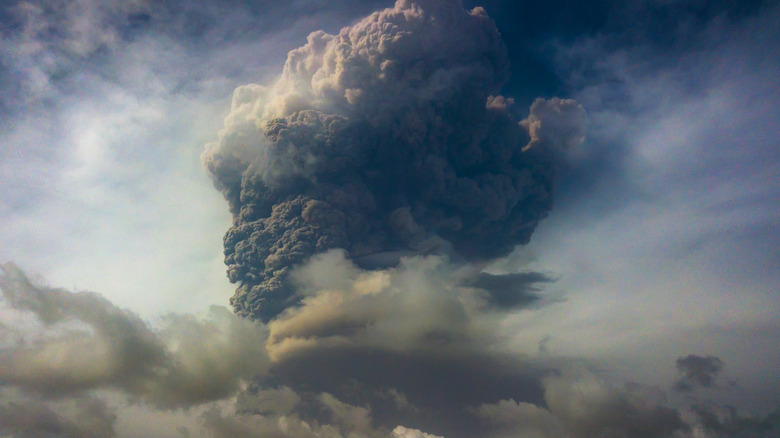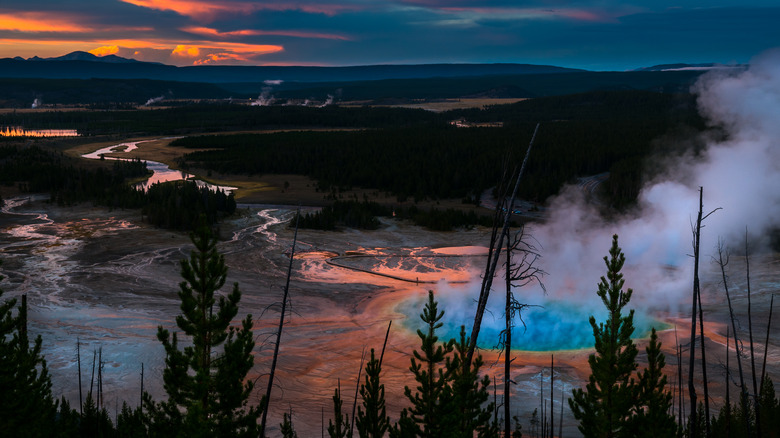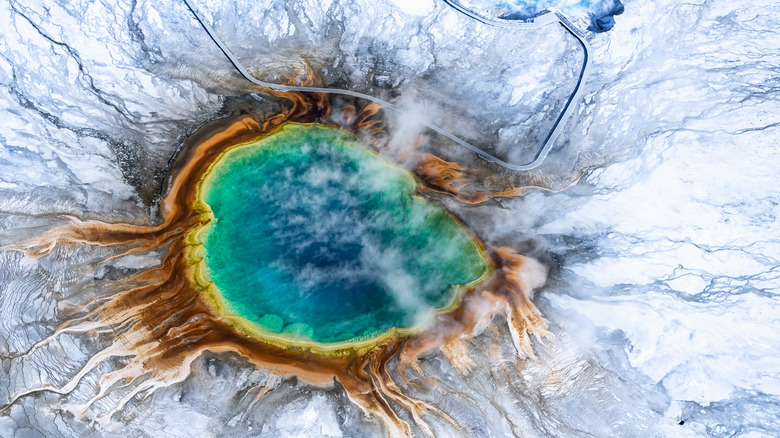The Yellowstone Volcano Theory That Would Change Everything
Wyoming's beautiful Yellowstone National Park is 3,500 square miles of pristine nature, featuring impressive geysers and clear springs formed over the millennia as a result of the area's highly active subterranean volcanos. These volcanoes have been the site of some of the most seismic eruptions to ever take place on the surface of the Earth (via National Geographic). Yellowstone's last "supereruption" is believed by scientists to have occurred some 640,000 years ago, and now many believe that an eruption of epic proportions is now long overdue.
"It has erupted before and it will erupt again," claims Mike Szydlowski, a science coordinator for Columbia Public Schools (per Columbia Daily Tribune). The imminent eruption of the Yellowstone supervolcano has been described as a catastrophic event that could kill and displace millions, send the western world into disarray, and potentially spell the end of humanity as we know it.
Per the same source, a super eruption would destroy the local area instantly, while the resulting earthquakes would rock cities across America. The explosion would send a column of ash miles into the air, which would choke the surrounding airspace and ground flights. Meanwhile, for thousands of miles, buildings and land would be covered in volcanic ash up to ten feet deep, shutting down factories, power plants, and making the rescue of local people almost impossible (per Vox). The BBC reports that the eruption of such a supervolcano would result in a long "volcanic winter," in which food would become scarce and humanity would face mass starvation.
Is the US government preparing for the eruption of Yellowstone?
The scenario is the stuff of nightmares: The world's deadliest natural disaster is lying in wait under our feet, and no one has any way to stop it. But back in 2014, reports emerged that the U.S. government had been secretly making decisive steps to mitigate the effects of the imminent eruption. The South African news website Praag claimed that the U.S. government had approached the African National Congress and offered the sum of $100 billion over the course of ten years for the construction of temporary housing intended to provide shelter for millions of Americans likely to be displaced by the eruption of the Yellowstone Supervolcano (via the Daily Mail).
Meanwhile, in 2017 the BBC reported that NASA scientists — concerned by the bleak warning of food storages after the eruption of a supervolcano — had begun work on devising potential methods by which supervolcanoes such as Yellowstone might be "cooled down," and thus rendered effectively inactive. But how could this be accomplished? There are few ideas on the table. One is to funnel water into the volcano via an aqueduct, which is not the ideal path forward as it would be financially costly and extremely difficult. Another plan — which NASA is apparently taking a serious look at — is drilling a hole down into the supervolcano and using it to pump water inside. Still, it's a risky proposition. "If you drill into the top of the magma chamber and try and cool it from there, this would be very risky," said Brian Wilcox of NASA's Jet Propulsion Laboratory (JPL) at the California Institute of Technology.
The truth about Yellowstone is (reassuringly) dull
Actual experts, however, have been quick to throw cold water on the very idea that Yellowstone is set to catastrophically combust at any moment — meaning that tales of secret contingency plans by the U.S. government are likely to be fabricated. In a recent interview with Eos, Michael Poland explained that the volcano — or, more accurately, volcanic "caldera complex" — poses little immediate danger. "Yellowstone is not going to erupt again anytime soon, and when it does, it's much more likely to be a lava flow than an explosive event," he said. "These lava flows are really impressive. They can be hundreds of feet thick. But they're not particularly hazardous beyond the immediate area."
Poland went as far as to call the Yellowstone "supervolcano" theory a myth, claiming: "The most common misconception about Yellowstone is that it's overdue for an eruption. But volcanoes don't work like that," he said. Reassuringly, the website of the United States Geological Survey (USGS) echoes Poland in a statement that begins simply: "Yellowstone is not overdue for an eruption." The statement explains that volcanic "schedules" cannot be deduced from past activity, and even if they could, the Yellowstone Caldera has erupted just three times in over 2 million years — too few for any pattern to be established. Even if one were to do so, the next eruption would still be 100,000 years from now, so it seems we can all sleep easy. Phew.


